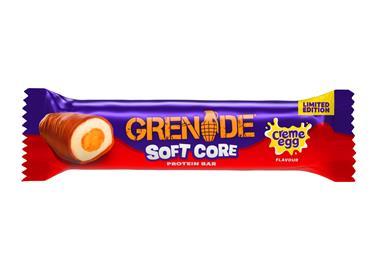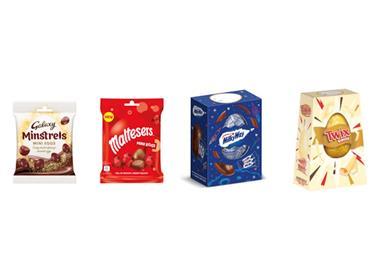Chewing gum takes up minimal space in store, but can deliver mammoth sales if retailers ensure good visibility
They say that good things come in small packages and this couldn’t be more true of chewing gum. “Chewing gum is a very important category; it’s the highest sales profit per square foot in the store,” says Robert Teal, owner of Lifestyle Express, Barnsley. “It takes up the least space and you don’t have to chill it, whereas if you look at a category like cigarettes it takes up a lot of time.”
The market continues to perform well with the total gum category worth £285m, up 1.3% year on year. Market leader Wrigley’s gum portfolio is worth £268m and is performing ahead of the total gum category at 2.6% (Nielsen MAT value, week ending 16 May 2015).
The firm has given Extra a major makeover for 2015, updating packaging and reformulating the gum to improve its taste, freshness and cleaning attributes. Wrigley is supporting the brand with a £15m marketing spend this year.
Extra is a top performer at Paul Stone’s five Spar stores in Manchester. “We sell an awful lot of gum,” he says. “It’s a key product at till point. Gum sales are fairly steady and we make healthy margins. Our best-sellers are Extra peppermint and spearmint.”
Robert’s gum category is also performing well. “Sales are slightly up in the past few months, but gum was already good, so to grow an established product is great.” The key to his recent success has largely been down to ensuring he has full shelves, he claims. “It’s simple - we’ve improved our availability. Availability is a challenge because we sell so much that we’re having to fill up the fixture in the morning and afternoon.”
Indeed, while good availability is crucial for any category, it is especially important for gum - as is visibility - because it is such a highly impulsive purchase, more so than any other confectionery product. “Some 62% of single gum purchases are unplanned,” says Julio Guijarro, Wrigley UK and Ireland marketing director. “Gum is a hugely impulsive category (50% of shoppers who see gum buy it) and therefore visibility is key to driving sales.”
Positioning in store
Paul finds himself torn between displaying gum on the counter, which he worries can look messy, and displaying it below the counter, where he fears it will be overlooked. “There’s always an argument of gum being on top of the counter or below. We have it below to look less cluttered in three of our stores and on the counter in the other two. It sells better above, but from a design point of view it’s not great.”
Robert has opted for dual counter displays. “We used to just have one display unit in our old shop and when we relocated to a slightly larger store and went to a twin counter position we increased our sales and broadened our range,” says Robert, noting that bubblemint has been a big seller at his store.
Mouthwash makes a mark on convenience
With most UK adults spending well under the recommended two minutes brushing their teeth, additional oral care products such as mouthwash are being purchased to help tackle plaque, decay and bad breath and avoid a costly trip to the dentist.
“During the recession consumers developed a number of tactics aimed at preventing unexpected costs,” says Andrew Freestone, commercial director at SHS Sales & Marketing, which distributes Listerine. “Oral care benefitted in that consumers chose to incorporate products such as mouthwash into their daily regime in order to avoid incurring costly dental bills in the future. This holistic approach has continued even though the economic conditions are less severe than they have been.”
The mouthwash market within convenience delivered almost £3m in sales last year, showing a 4% growth in sales versus the previous 12 months (Nielsen MAT, 52 week - value - impulse to 14 February 2015). This growth of 4% significantly outperforms the decline of 3% which has been experienced at a total market level. Says Freestone: “With a 70% share of total sales within the category Listerine sales delivered more than £2m to the category in the past 12 months, growing by over 2.5%.”
This certainly rings true at Londis Hemingborough in Selby, Yorkshire. “We stock mouthwash, dental floss, denture fix, toothpaste and toothbrushes. We sell plenty of mouthwash - people want to look after their teeth,” says owner Teresa Turner.
“We sell the standard and mild Listerine mouthwashes and a Colgate one, too, but it doesn’t have the same impact as Listerine.”
The Listerine brand will benefit from £4m in media spend in 2015 to drive awareness and trial among consumers.
“We have two display positions in store - one next to each till - and we’ve got 24 lines of chewing gum across the two with the best-selling lines duplicated,” he says. “If retailers sat down and worked out how much they made from gum, they would increase the space they allow for it.”
In addition to displaying gum on the counter, there are several other options that could help to boost sales, notes Guijarro. “With regard to secondary siting, if there’s a second till point then use that; if there’s an oral care point in store then put it there. Or put it together with food-to-go items.”
Elliott Silcox, supervisor at Silcox Stores in Pontnewydd, Gwent, puts secondary sitings of gum near snacks and confectionery. “We have little display pods around the store, so we’ve put gum by crisps and sweets. It does work, you see customers picking them up,” he says.
Oral health benefits
Paul has seen good results from having additional sitings. As well as till point sitings, he displays gum in his confectionery fixture as well as by the sandwiches on a slatted end panel in his Oxford Road and City Tower stores.
This positioning ties in with Wrigley’s ‘Eat, Drink, Chew’ campaign, which encourages consumers to chew sugar-free gum after eating in order to maintain good oral health. “I think the message is getting across - people have seen the Wrigley ads with the donuts following people around and they get the idea that gum helps,” Paul says.
But Robert thinks that people still see gum as simply a breath freshener. “Customers’ reason for buying it is for fresh breath, rather than a wider oral care concern,” he says. “It’s a good idea [to promote gum as an oral care product], but these changes require considerable marketing effort for an extended period of time. But it would be a very good thing for sales and bring money into other non-gum oral care products.”
Wilf Hardman, owner of Newsmart in Bolton, agrees that gum is often consumed simply to freshen breath. “People buy it going to work. They buy something to eat, such as a tuna sandwich, and they pick up gum as a breath freshener for after. You also notice people buying it with cigarettes for the same reason.”
However, he notes that consumers who are especially interested in gum’s oral care benefits opt for Extra Ice products. “People are trying the Extra Ice products with microgranules for oral hygiene reasons,” he says.
Guijarro concedes that while Wrigley has already invested a considerable amount into its oral health campaign, there is still plenty of work to do. “It’s a long journey communicating the Eat, Drink, Chew message to show that chewing sugar-free gum provides benefits.”
Nevertheless, Wrigley is confident that it is the future of the gum category. “The trend towards oral care shows no signs of slowing, as chewers seek out a healthy addition to their day-to-day oral care routine,” he says. As a result, the company is bringing back its best-selling Extra Ice spearmint flavour. “The re-formulation of Extra Ice spearmint aims to capitalise on this trend, enforcing the oral healthcare benefits of chewing sugar-free gum and helping retailers drive sales.” Available in 10-pellet packs with an rrp of 49p, the reformulated product features an improved cooling sensation.
The company has also recently introduced two new Extra soft-chew flavours - strawberry and bubblegum - as well as moving Orbit Complete spearmint and peppermint variants under the Extra brand.
“Orbit had a loyal following, but the move to Extra will allow Orbit to benefit from a leading brand,” says Guijarro. “We don’t see any signs of people dropping off. The new Extra flavours, strawberry and bubblegum, meet the growing trend of fruit-flavoured products.”
Elliott has been spreading the word at Silcox Stores. “I had customers asking where Orbit had gone, so I explained that it had been rebranded. The new strawberry flavour is selling well. It’s really nice.”
Extra soft gum is selling well at Wilf’s store, too. “In addition to the Wrigley stand at my main till, I also have an additional stand on my second till with four boxes of the new Extra strawberry and bubblegum flavours; they are doing well.”
Go large
Larger pack sizes are also proving popular. Wrigley launched a range of 46-pellet bottles in 2013 and with five million sold in their first year, a bubblemint variant was added last year.
“Wrigley has done really well with tubs,” says Paul. “They’ve changed the consumer a bit as it makes gum more of a planned purchase. Speaking from personal experience, I always have a tub in my car.”
Elliott has also found that the bottles are in demand. “Bubblemint pots are going well, and spearmint and peppermint 60-piece pots. When Wrigley re-branded the pots we saw sales increase.”
Robert has found upselling the tubs to be an effective way of boosting sales. “If people are buying a couple of sticks, we’ll upsell them a tub. The tubs are a very successful product for us. We sell 20 outers a week, which is good as we’re only 350sq ft. Bubblemint tubs are our best-seller.”
Meanwhile Baba Butt, owner of five stores in Reading, Berkshire, has seen strong sales of Handy boxes of Extra spearmint and peppermint. “The handy boxes do especially well; the larger packs make a difference,” he says. “We used to sell more sticks, but now we sell more boxes, which is good as boxes retail at £1 whereas the sticks are 49p.”
So while gum can pretty much be relied upon to sell well, with minimum input from the retailer, a little time spent choosing the right products, pack formats and display locations for your store will maximise profit and ensure the category stays fresher than fresh.
Gum facts
Gum is most likely to be bought on a food to go mission
13% of gum shoppers only buy gum and nothing else
1 in every 100 customers will buy gum
1 in 20 customers aged 18 and under buys gum
1 in 50 customers aged 16-25 will buy gum (gender, social class don’t make a difference on likelihood to buy gum in c-stores)
1 in 50 customers in London buys gum
A higher proportion of shoppers buy gum in stores under 2,000 sq ft vs over 2000sq ft, and also in transient stores vs neighbourhood
Sourch: HIM
Source
Sarah Britton
































No comments yet